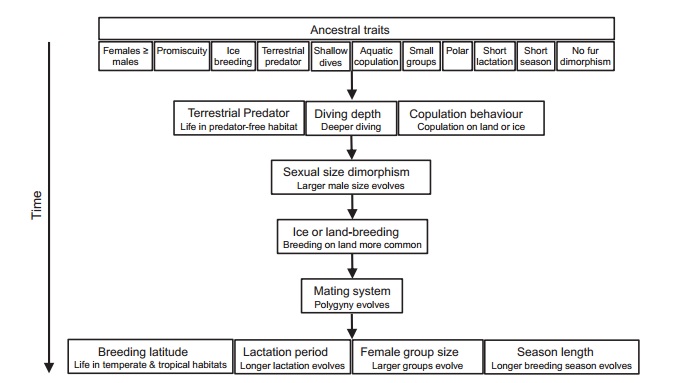Mating System of the California Sea Lion (Zalophus californianus)
Biology 342, Fall 2014
Audrey Spaeth
How It Evolved
California sea lions are members of the family Otariidae (eared seals), which includes other species of sea lions and fur seals. Otariidae is one of three families of pinnipeds—the other two being walruses (Odobenidae) and true seals (Phocidae)—all of which are part of the wider order Carnivora, which includes cats, dogs, bears, and weasels (see below for a phylogenetic tree of pinnipeds). Pinnipeds were once terrestrial mammals. Only within the past thirty million years have they evolved into the semi-marine mammals of today (Arnason et al. 2006).
Extreme sexual size dimorphism and a harem-based mating system are present in all species of Otariidae and in two species of Phocidae (northern and southern elephant seals). Sexual dimorphism often implies a case of sexual selection (more on sexual selection). The remaining pinniped species show moderate to no sexual size dimorphism, and mating systems range from moderately polygynous to monogamous and “promiscuous” (Reidman 1990).
 |
|
The Old Story
With limited safe haul-out sites on land, groups of sea lions tended to clump, especially females who needed protection for their pups. As a result of this congregation of females, some males could mate with many females and the most successful males were the largest, who could fight off rival males. Rival males also harassed females, further encouraging females to clump for protection in the territory of a large dominant male. Size was then a sexually selected trait in males and extreme sexual dimorphism evolved as a result (Bartholomew 1970). This is the commonly accepted narrative of the evolution of the extreme sexual dimorphism and the mating system of Otariidae, including California sea lions.
The New Story
However, a recent study (Krüger et al. 2014) calls this narrative into question and concludes that ecological considerations may have played more of a role than social ones. The study examined the life history traits (such as breeding season, male and female size, diving depth, and harem size) of all pinniped species and compared them to evolutionary relationships determined by phylogenetic analysis. The conclusion (summarized in the chart below) was that sexual size dimorphism evolved first, as a result of either differing foraging in the sexes (males became larger to be able to dive deeper and reduce foraging competition with females) and/or that larger males were more successful at forcing copulation. The social system of harems evolved only secondarily as a result of size dimorphism. However, once the system was established, it enhanced sexual selection and secondary sexual traits evolved at a faster rate than non-sexual traits.
 |
|